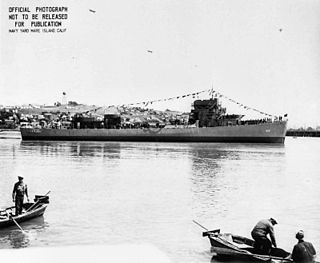
The USS Alnitah (AK-127) was a Crater-class cargo ship in the service of the US Navy in World War II. Named a spelling variation of the star Alnitak in the constellation Orion, it was the only ship of the Navy to bear this name.

USS Kaskaskia (AO-27) was a Cimarron-class fleet replenishment oiler serving in the United States Navy, named for the Kaskaskia River in Illinois.
USS Gazelle (IX-116), an unclassified miscellaneous vessel, was the third ship of the United States Navy to be named for the gazelle, any of numerous small, graceful, and swift antelopes, with lustrous eyes, found especially in South Africa, northern Africa, Iran, and India. She was built as an auxiliary oiler, launched on 9 November 1943 by the California Shipbuilding Corporation, at Wilmington, Los Angeles, as SS Cyrus K. Holliday sponsored by Mrs. J. E. Stewart, and acquired by the Navy and simultaneously commissioned on 29 November 1943.
USS Armadillo (IX-111), the lead ship of her class of tanker was the only ship of the United States Navy to be named for the armadillo, an insect-eating mammal which has an armorlike shell encasing its back and head.
USS Gemsbok (IX-117), an Armadillo-class tanker designated an unclassified miscellaneous vessel, was the second ship of the United States Navy to be named for the gemsbok, a large, handsome species of straight-horned African antelope. Her keel was laid down as Carl R. Gray by the California Shipbuilding Corporation, in Wilmington, Los Angeles. She was launched on 9 November 1943 sponsored by Miss E. Jeffers, acquired and simultaneously commissioned on 3 December 1943. She was renamed Gemsbok upon acquisition.

USS Lackawanna (AO-40) was a Kennebec-class type T2 fleet oiler of the United States Navy. The ship was laid down 27 December 1941, as SS Conastoga, by the Bethlehem-Sparrows Point Shipyard Inc., Sparrows Point, Maryland, under Maritime Commission contract number 147. Launched on 16 May 1942, sponsored by Mrs. S. J. Dickey, acquired by the Navy on 20 June 1942, and commissioned on 10 July 1942 at Baltimore, Lt. Comdr. S. R. Sands, Jr., USCG, in command.

USS Saugatuck (AO-75) was a Suamico-class replenishment oiler of the United States Navy.

USS Emery (DE-28) was an Evarts-class destroyer escort constructed for the United States Navy during World War II. It was promptly sent off into the Pacific Ocean to protect convoys and other ships from Japanese submarines and fighter aircraft. By the end of the war, she had accumulated three battle stars.

USS Neshanic (AO-71) is a former T3 Kennebec-class oiler constructed for the United States Navy during World War II. She was the only U.S. Navy ship named for the Neshanic River in New Jersey.

USS Weaver (DE-741) was a Cannon-class destroyer escort in service with the United States Navy from 1943 to 1947. In 1952, she was sold to Peru, where she served as BAP Rodriguez (D-63) until being decommissioned and scrapped in 1979.

USS Lamons (DE-743) was a Cannon-class destroyer escortin service with the United States Navy from 1944 to 1946. She was sold for scrapping in 1973.

USS Mascoma (AO-83) was a Escambia-class replenishment oiler constructed for the United States Navy during World War II. She served her country in the Pacific Ocean Theatre of Operations, and provided petroleum products where needed to combat ships. For her very dangerous work under combat conditions, she was awarded seven battle stars by war's end.

USS Niobrara (AO-72) was a T3 Kennebec-class oiler constructed for the United States Navy during World War II. She was the only U.S. Navy ship named for the Niobrara River in Nebraska.

USS Chikaskia (AO-54) was a Cimarron-class fleet oiler acquired by the U.S. Navy during World War II. She served her country primarily in the Pacific Ocean Theatre of Operations, and provided petroleum products where needed to combat ships. For her very dangerous work under combat conditions, she was awarded six battle stars for World War II and one for the Korean War.

USS Cahaba (AO-82) was an Escambia-class replenishment oiler acquired by the United States Navy for use during World War II. She had the dangerous but necessary task of providing fuel to vessels in combat and non-combat areas primarily in the Pacific Ocean. For her brave efforts, she received eight battle stars during the war.

USS Enoree (AO-69) was a Chiwawa-class oiler constructed for the United States Navy during World War II. She was the only U.S. Navy ship named for the Enoree River in South Carolina.

USS Caelum (AK-106) was a Crater-class cargo ship commissioned by the US Navy for service in World War II. Caelum was named after the constellation Caelum. She was responsible for delivering troops, goods and equipment to locations in the Asiatic-Pacific Theater.

USS Alkes (AK-110) was a Crater-class cargo ship commissioned by the US Navy for service in World War II, named after Alkes, a star in the Crater constellation. She was responsible for delivering troops, goods and equipment to locations in the war zone.

USS Ascella (AK-137) was a Crater-class cargo ship commissioned by the US Navy for service in World War II. Ascella was named after Ascella, a star in the constellation Sagittarius. She was responsible for delivering troops, goods and equipment to locations in the Asiatic-Pacific Theater.

USS Maquoketa (AOG-51) was a Patapsco-class gasoline tanker in service with the United States Navy from 1945 to 1947 and with the Military Sea Transportation Service from 1952 to 1957. She was sold for scrap in 1975.
















